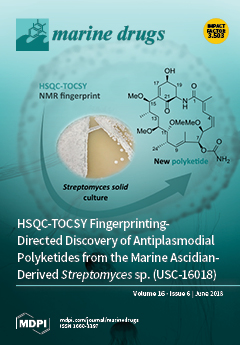Three new diastereomers of polyketides (PKs), raistrickiones A−C (
1–
3), together with two new analogues, raistrickiones D and E (
4 and
5), were isolated from a highly productive strain of
Penicillium raistrickii, which was subjected to an
[...] Read more.
Three new diastereomers of polyketides (PKs), raistrickiones A−C (
1–
3), together with two new analogues, raistrickiones D and E (
4 and
5), were isolated from a highly productive strain of
Penicillium raistrickii, which was subjected to an experimental thermo-change strategy to tap its potential of producing new secondary metabolites. Metabolites
1 and
2 existed in a diastereomeric mixture in the crystal packing according to the X-ray data, and were laboriously separated by semi-preparative HPLC on a chiral column. The structures of
1–
5 were determined on the basis of the detailed analyses of the spectroscopic data (UV, IR, HRESIMS, 1D, and 2D NMR), single-crystal X-ray diffractions, and comparison of the experimental and calculated electronic circular dichroism spectra. Compounds
1–
5 represented the first case of 3,5-dihydroxy-4-methylbenzoyl derivatives of natural products. Compounds
1–
5 exhibited moderate radical scavenging activities against 1,1-diphenyl-2-picrylhydrazyl radical 2,2-diphenyl-1-(2,4,6-trinitrophenyl) hydrazyl (DPPH).
Full article






